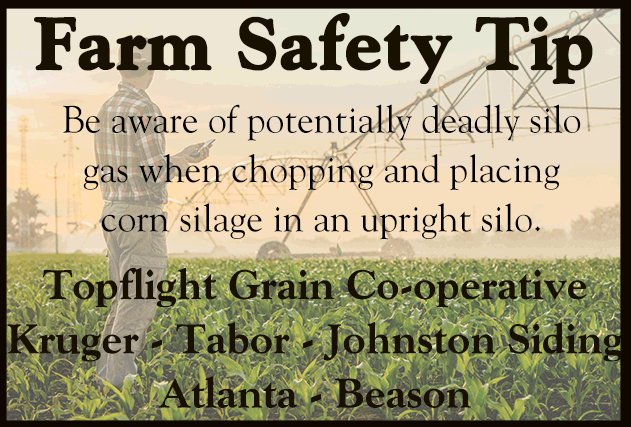|
 Rainfall in our area was
spotty at best. At my house in East Lincoln Township, I had 18.88
inches of rain from April through September. April and June were low
on the totals with less than 1.5 inches each. September had just
over two inches, while May, July and August all had over four
inches. Although things remain dry in our area, we were blessed
compared to areas to the east of us. Of course, the old expression
about being “under the cloud” for rainfall held very true this year.
Some areas continued to have exceptional rainfall amounts “when
under the cloud,” while nearby areas missed those rains completely.
The climate seems to be warming and having more intense rainfall in
some areas. We could debate all day on the “cause” such as
historical cycle patterns, greenhouse gas emissions, or combinations
of these. The end results are variability in moisture for crops, and
slightly warmer growing conditions. Rainfall in our area was
spotty at best. At my house in East Lincoln Township, I had 18.88
inches of rain from April through September. April and June were low
on the totals with less than 1.5 inches each. September had just
over two inches, while May, July and August all had over four
inches. Although things remain dry in our area, we were blessed
compared to areas to the east of us. Of course, the old expression
about being “under the cloud” for rainfall held very true this year.
Some areas continued to have exceptional rainfall amounts “when
under the cloud,” while nearby areas missed those rains completely.
The climate seems to be warming and having more intense rainfall in
some areas. We could debate all day on the “cause” such as
historical cycle patterns, greenhouse gas emissions, or combinations
of these. The end results are variability in moisture for crops, and
slightly warmer growing conditions.

Cover crop acceptance in production agriculture continues to
increase. Touted benefits include better weed control, preventing
nitrogen loss from fields, and removal of carbon dioxide from the
atmosphere. The use of cover crops may qualify producers for
payments in regard to carbon sequestration. These programs are
usually facilitated by companies providing for access to a carbon
exchange where the credits are then bought by companies seeking to
offset some of their carbon dioxide production. Between payments for
tillage reductions and cover crops, it helps pay for the cover crop
seed.
Farm expenses have been in the same upward trend as consumer goods,
and maybe at a much larger percentage increase. This rapid increase
will continue to put pressure on farm profitability. According to
the U of I crop budgets from Gary Schnitkey et al, the anticipated
farmer return is $8 per acre for corn and $43 per acre for soybeans
for the upcoming year. Many assumptions go into those figures
including yields of 227 for corn and 72 for soybeans, prices of
$5.30 for corn and $12.70 for soybeans, and land cost of $341 per
acre among them. This makes for a tight bottom line anticipated for
farmers for next year.
The supply chain disruptions continue to affect the agriculture
industry, as well as the home consumer. Availability of farm
equipment, parts to service and repair equipment, and transportation
for parts and equipment have become harder to come by, and more
expensive. Some agricultural manufacturers are reportedly sold out
for their anticipated 2023 production at this point. Many of the
same issues affecting the automobile market are present in the farm
equipment trade. Labor shortages, chip shortages, and transportation
costs and backlogs are all affecting the availability of parts and
equipment.
[to top of second column] |

The used equipment market also
compares to what the auto market has seen. The narrowly averted rail
transportation strike would have compounded availability of parts
and shipment of commodities alike, not to mention the effects on the
consumer goods market.
Agriculture producers continue
to look for opportunities to diversify their operations to improve
profitability. One of the fledgling crops is hemp. Sort of. Hemp
production was big in the central Illinois area during the WWII era
as it was used to produce rope. It went away, and now is coming
back. Maybe rope isn’t the main product produced, but research is
underway on how to use the entire plant rather than just producing
CBD oil. The industry is still in its infancy, and hemp is really a
specialty crop at this point. As with any specialty crop, available
markets are usually a challenge. When markets become more available
on a local basis, the industry will grow rapidly.
Let’s look forward to a safe and bountiful harvest as we finish up
the 2022 growing season, and a good head start for the next year!
[John Fulton]

|